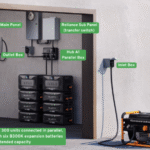Rise of Renewable Energy: The Future of Power Generation
The world is witnessing a seismic shift in the way we generate power. Renewable energy sources, such as solar and wind power, are gaining traction as the world moves away from fossil fuels. In 2020, renewables accounted for 26% of global electricity generation, up from 22% in 2010. This trend is expected to continue, with the International Energy Agency (IEA) predicting that by 2050, 60% of the world’s electricity will come from renewable sources.
### The Solar Revolution
Solar power has emerged as a leading player in the renewable energy landscape. In 2020, solar accounted for 38% of the world’s renewable energy capacity, followed by wind power at 28%. The cost of solar energy has dropped dramatically over the past decade, making it more competitive with fossil fuels. In the United States, the cost of solar energy has fallen by 70% since 2010, making it a viable alternative for households and businesses.
### Wind Power on the Rise
Wind power is another significant contributor to the renewable energy mix. In 2020, wind accounted for 18% of the world’s renewable energy capacity. Offshore wind farms, in particular, are gaining popularity, with the world’s largest offshore wind farm, the Walney Extension, located off the coast of the UK. Wind power is becoming increasingly cost-competitive with fossil fuels, with the cost of onshore wind energy falling by 64% over the past decade.
### The Future of Energy Storage
As the world transitions to renewable energy, energy storage is becoming a critical component. Batteries are playing a key role in storing excess energy generated by solar and wind power, allowing for a stable and reliable energy supply. The cost of batteries has fallen by 80% over the past decade, making them a viable solution for households and businesses.
### The Path Forward
The shift to renewable energy is not without its challenges. Infrastructure, policy, and public awareness are all crucial components of this transition. Governments must create policies to support the growth of renewable energy, while also investing in infrastructure to support the integration of renewables into the grid. As consumers, we must also play a role by making conscious choices about our energy use and supporting companies that prioritize sustainability.




_1.png?w=150&resize=150,150&ssl=1)


(1).png?w=150&resize=150,150&ssl=1)